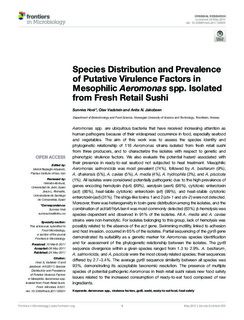| dc.contributor.author | Hoel, Sunniva | |
| dc.contributor.author | Vadstein, Olav | |
| dc.contributor.author | Jakobsen, Anita Nordeng | |
| dc.date.accessioned | 2017-05-31T07:28:06Z | |
| dc.date.available | 2017-05-31T07:28:06Z | |
| dc.date.created | 2017-05-30T09:26:06Z | |
| dc.date.issued | 2017 | |
| dc.identifier.issn | 1664-302X | |
| dc.identifier.uri | http://hdl.handle.net/11250/2443925 | |
| dc.description.abstract | Aeromonas spp. are ubiquitous bacteria that have received increasing attention as human pathogens because of their widespread occurrence in food, especially seafood and vegetables. The aim of this work was to assess the species identity and phylogenetic relationship of 118 Aeromonas strains isolated from fresh retail sushi from three producers, and to characterize the isolates with respect to genetic and phenotypic virulence factors. We also evaluate the potential hazard associated with their presence in ready-to-eat seafood not subjected to heat treatment. Mesophilic Aeromonas salmonicida was most prevalent (74%), followed by A. bestiarum (9%), A. dhakensis (5%), A. caviae (5%), A. media (4%), A. hydrophila (2%), and A. piscicola (1%). All isolates were considered potentially pathogenic due to the high prevalence of genes encoding hemolysin (hlyA) (99%), aerolysin (aerA) (98%), cytotoxic enterotoxin (act) (86%), heat-labile cytotonic enterotoxin (alt) (99%), and heat-stable cytotonic enterotoxin (ast) (31%). The shiga-like toxins 1 and 2 (stx-1 and stx-2) were not detected. Moreover, there was heterogeneity in toxin gene distribution among the isolates, and the combination of act/alt/hlyA/aerA was most commonly detected (63%). β-hemolysis was species-dependent and observed in 91% of the isolates. All A. media and A. caviae strains were non-hemolytic. For isolates belonging to this group, lack of hemolysis was possibly related to the absence of the act gene. Swimming motility, linked to adhesion and host invasion, occurred in 65% of the isolates. Partial sequencing of the gyrB gene demonstrated its suitability as a genetic marker for Aeromonas species identification and for assessment of the phylogenetic relationship between the isolates. The gyrB sequence divergence within a given species ranged from 1.3 to 2.9%. A. bestiarum, A. salmonicida, and A. piscicola were the most closely related species; their sequences differed by 2.7–3.4%. The average gyrB sequence similarity between all species was 93%, demonstrating its acceptable taxonomic resolution. The presence of multiple species of potential pathogenic Aeromonas in fresh retail sushi raises new food safety issues related to the increased consumption of ready-to-eat food composed of raw ingredients. | nb_NO |
| dc.language.iso | eng | nb_NO |
| dc.publisher | Frontiers Media | nb_NO |
| dc.rights | Navngivelse 4.0 Internasjonal | * |
| dc.rights.uri | http://creativecommons.org/licenses/by/4.0/deed.no | * |
| dc.title | Species distribution and prevalence of putative virulence factors in mesophilic Aeromonas spp. isolated from fresh retail sushi | nb_NO |
| dc.type | Journal article | nb_NO |
| dc.type | Peer reviewed | nb_NO |
| dc.source.volume | 8 | nb_NO |
| dc.source.journal | Frontiers in Microbiology | nb_NO |
| dc.identifier.cristin | 1472677 | |
| dc.description.localcode | This Document is Protected by copyright and was first published by Frontiers. All rights reserved. it is reproduced with permission. Copyright © 2017 Hoel, Vadstein and Jakobsen. This is an open-access articledistributed under the terms of the Creative Commons Attribution License (CC BY).The use, distribution or reproduction in other forums is permitted, provided theoriginal author(s) or licensor are credited and that the original publication in thisjournal is cited, in accordance with accepted academic practice. No use, distributionor reproduction is permitted which does not comply with these terms | nb_NO |
| cristin.unitcode | 194,66,15,0 | |
| cristin.unitcode | 194,68,20,70 | |
| cristin.unitname | Institutt for bioteknologi | |
| cristin.unitname | Institutt for matteknologi | |
| cristin.ispublished | true | |
| cristin.fulltext | original | |
| cristin.qualitycode | 1 | |

